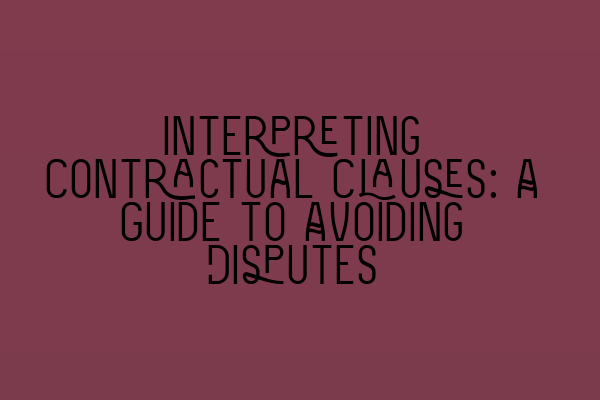Interpreting Contractual Clauses: A Guide to Avoiding Disputes
The ability to interpret contractual clauses accurately is a vital skill for solicitors. In the world of contract law, disputes often arise due to disagreements over the meaning and intent of specific provisions within the agreement. A careful and meticulous approach to interpreting these clauses can help avoid legal battles and ensure the smooth execution of the contract.
In this comprehensive guide, we will discuss the key principles and techniques for interpreting contractual clauses. Whether you are a solicitor, a law student, or a business professional, this article will provide you with valuable insights to navigate this crucial aspect of contract law.
1. The Importance of Clear and Precise Language
Before delving into the intricacies of interpreting contractual clauses, it is essential to emphasize the significance of clear and precise language in drafting agreements. The way a clause is worded can directly impact its interpretation and potential for disputes.
Using unambiguous language and avoiding vague terms or ambiguous expressions can minimize the chances of misunderstandings and conflicts. As solicitors, it is our responsibility to draft contracts that leave no room for uncertainty or misinterpretations.
2. The Objective Approach: Extrinsic Evidence
When interpreting contractual clauses, it is crucial to adopt an objective approach. This means focusing on the objective intentions of the parties involved rather than their subjective intentions.
Extrinsic evidence, such as background facts, prior negotiations, and industry customs or practices, can provide valuable insight into the objective intentions of the parties. By considering these external factors, solicitors can better understand the context and purpose of the clauses and arrive at a more accurate interpretation.
However, it is important to note that extrinsic evidence should only be used to clarify ambiguous terms or resolve ambiguities. It should not be used to contradict or change the clear and unambiguous language of the contract.
3. Contra Proferentem Rule: Ambiguity in Favor of the Non-Drafter
In cases where a contractual clause is ambiguous, the principle of contra proferentem comes into play. This rule states that any ambiguity should be interpreted against the party who drafted the clause.
The rationale behind this rule is that the party who drafted the clause is typically in a superior position to ensure clarity and precision. By interpreting the ambiguity against the drafter, it encourages them to draft clear and precise terms in the future and avoids unfair advantage in favor of the drafter.
However, it is important to note that the contra proferentem rule is not applied in every situation. If the parties are of equal bargaining power and have negotiation processes in place, this rule may not be applicable.
4. Golden Rule: Avoiding Absurd or Unreasonable Interpretations
The golden rule of interpretation is to prioritize interpretations that avoid absurd or unreasonable outcomes. If a literal interpretation of a contractual clause leads to an absurd result, courts and solicitors can deviate from the literal meaning to achieve a more sensible outcome.
However, it is important to exercise caution when applying the golden rule, as it should only be used as a last resort. Clear and unambiguous language should be given precedence, and a departure from the literal meaning should be limited to extreme situations where it is necessary to avoid absurdity.
5. Dynamic Interpretation: Evolving Context and Circumstances
Contractual clauses are not static entities. They exist within a dynamic framework influenced by changing circumstances, markets, and business practices. Therefore, it is crucial to interpret clauses in light of these evolving contexts.
Solicitors should consider the business realities, market conditions, and any relevant legal or regulatory changes that have arisen since the contract was drafted. By taking into account these dynamic factors, solicitors can ensure that the interpretation of the clauses remains relevant and aligned with the parties’ intentions.
Conclusion
Interpreting contractual clauses involves careful and meticulous analysis to avoid disputes. Clear and precise language, an objective approach, the contra proferentem rule, the golden rule, and dynamic interpretation are crucial tools in this process.
By understanding and implementing these principles, solicitors can navigate the complexities of contractual interpretation and ensure the smooth execution of agreements. If you want to learn more about the legal profession, consider reading our related articles:
- Barrister vs. Solicitor: A Comprehensive Comparison
- Exploring Different Solicitor Specializations: Finding Your Niche
- Embracing the Rise of Virtual Law Practices
- Unveiling Real-Life Case Studies: Insights into Legal Practice and Decision-Making
- Exploring Solicitor Salaries in the UK: Average Earnings and Factors Affecting Income
